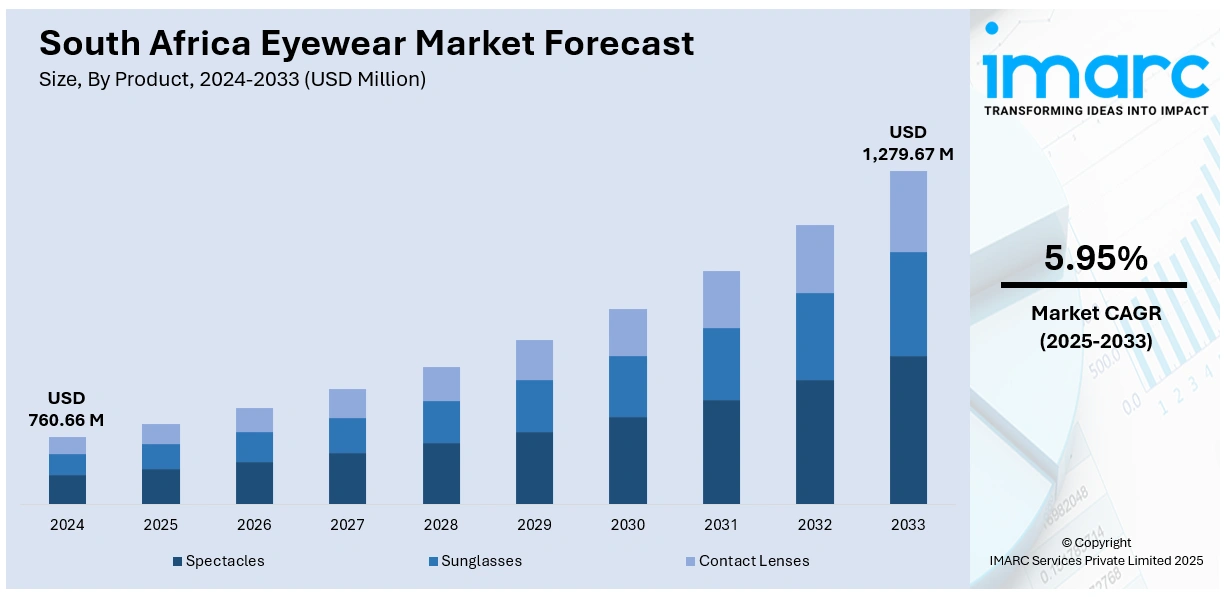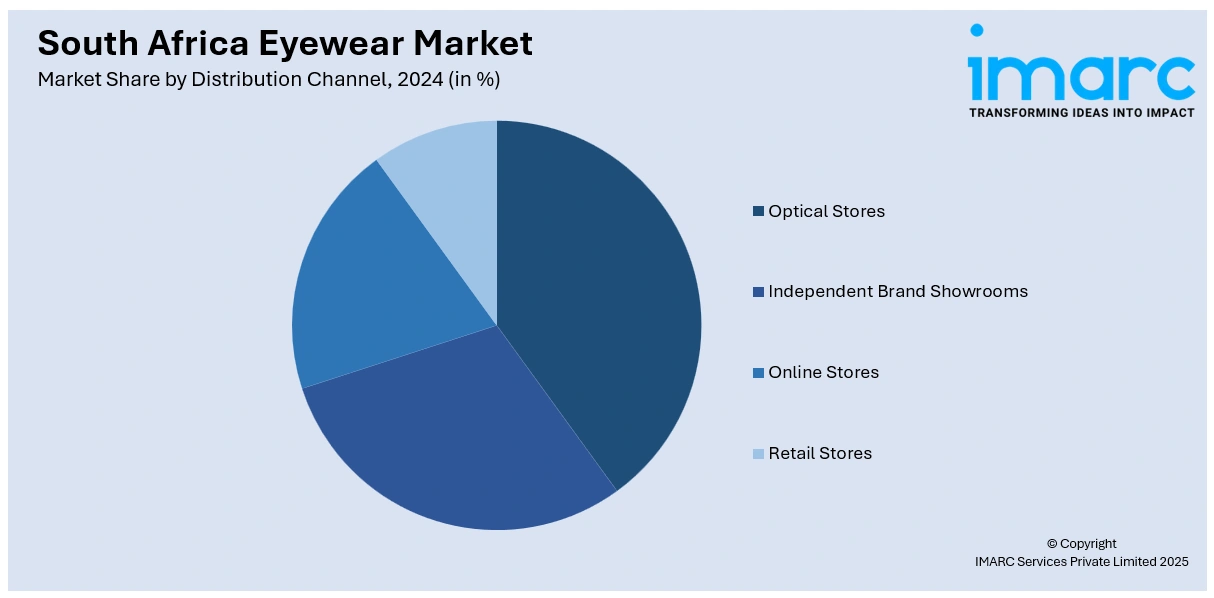
South Africa Eyewear Market Size, Share, Trends and Forecast by Product, Gender, Distribution Channel, and Region, 2025-2033
South Africa Eyewear Market Overview:
The South Africa eyewear market size reached USD 760.66 Million in 2024. The market is projected to reach USD 1,279.67 Million by 2033, exhibiting a growth rate (CAGR) of 5.95% during 2025-2033. The market is fueled by increasing vision care awareness, the desire for fashionable frames, and digital retail penetration. Both functional and style considerations are being prioritized by consumers, and e-commerce platforms are enabling wider access. Growing disposable income and urbanization further drive market growth. Long-term demand is being encouraged through strategic retail efforts, creative frame designs, and the use of advanced lens technologies. All these factors combined enable the rising South Africa eyewear market share in the region.
|
Report Attribute
|
Key Statistics
|
|---|---|
|
Base Year
|
2024
|
|
Forecast Years
|
2025-2033
|
|
Historical Years
|
2019-2024
|
| Market Size in 2024 | USD 760.66 Million |
| Market Forecast in 2033 | USD 1,279.67 Million |
| Market Growth Rate 2025-2033 | 5.95% |
South Africa Eyewear Market Trends:
Increased Prescription Eyewear Adoption
The population in South Africa has witnessed a significant surge in eye-related disorders, leading to amplified demand for prescription eyewear. Urbanization, aging, and improved health awareness have been the contributing factors, driving greater consumer spending on eye care and corrective lenses. Improved lens technology, including light-weighted materials and anti-reflective coatings, has also enhanced product attractiveness. Increasing penetration of optometry services in both urban and semi-urban areas is expanding access to quality spectacles. The trend mirrors overall growth in the South Africa eyewear market, with consumers highly opting for functional, durable, and comfortable spectacles. Retail growth through optical shops and online channels provides further momentum for uptake. Focus on customized prescriptions and fashionable frames is also driving buying habits, emphasizing changing market trends and demonstrating opportunity for continued market growth in both prescription and lifestyle categories.

To get more information on this market, Request Sample
Fashion-Forward Eyewear Demand
Fashion-oriented consumers in South Africa are increasingly looking for eyewear that is both stylish and functional, driving premium and designer frame growth. Trends encompass bright hues, creative frame designs, and limited-access collections targeting youth markets. Social media as well as celebrity endorsements play a significant role in determining tastes, and eyewear has become an accessory item beyond its functional use. Incorporation of eco-friendly materials like recycled acetate and bioplastics is intensely prominent as consumers become highly sensitive to environmental considerations. The industry is reacting with varying frame sizes that address lifestyle as well as aesthetic issues. This growing preference for fashion-forward eyewear lies at the heart of South Africa eyewear market growth, as it reflects changing consumer preferences. Such trends reflect the shifting dynamics market trends, as they point towards personalization and premiumization as consumers prioritize style and sustainability in their eyewear.
Expansion of Digital and Online Retail Channels
South African digital transformation has profoundly influenced eyewear distribution, with e-commerce as a key channel. Customers rely more on e-commerce websites and virtual try-on technology to discover and buy eyewear online. Online software allows precise customization, from prescription lenses to frame style, enhancing customer experience and interaction. Omnichannel tactics that integrate offline shops with sites provide greater accessibility, particularly in urban and semi-urban regions. Growing smartphone penetration, online payment options, and better logistics networks drive the growing trend of online shopping for eyewear. This trend impacts market growth directly by increasing reach and customer satisfaction. The adoption of technology-based retail solutions showcases changing South Africa eyewear market trends that point towards the digitalization and consumer experience-oriented shift of the sector.
South Africa Eyewear Market Segmentation:
IMARC Group provides an analysis of the key trends in each segment of the market, along with forecasts at the country and regional levels for 2025-2033. Our report has categorized the market based on product, gender, and distribution channel.
Product Insights:
- Spectacles
- Sunglasses
- Contact Lenses
The report has provided a detailed breakup and analysis of the market based on the product. This includes spectacles, sunglasses, and contact lenses.
Gender Insights:
- Men
- Women
- Unisex
A detailed breakup and analysis of the market based on gender have also been provided in the report. This includes men, women, and unisex.
Distribution Channel Insights:

- Optical Stores
- Independent Brand Showrooms
- Online Stores
- Retail Stores
The report has provided a detailed breakup and analysis of the market based on the distribution channel. This includes optical stores, independent brand showrooms, online stores, and retail stores.
Regional Insights:
- Gauteng
- KwaZulu-Natal
- Western Cape
- Mpumalanga
- Eastern Cape
- Others
The report has also provided a comprehensive analysis of all the major regional markets, which include Gauteng, KwaZulu-Natal, Western Cape, Mpumalanga, Eastern Cape, and others.
Competitive Landscape:
The market research report has also provided a comprehensive analysis of the competitive landscape. Competitive analysis such as market structure, key player positioning, top winning strategies, competitive dashboard, and company evaluation quadrant has been covered in the report. Also, detailed profiles of all major companies have been provided.
South Africa Eyewear Market News:
- In December 2024, SOEK™ introduced its Premium 100% Plant-Based Sunglasses line in South Africa and other international markets. Made from biodegradable materials such as castor seed oil and Bio-Acetate, the range marries eco-friendly innovation with fashion-oriented design, affirming SOEK™'s dominance in the South Africa eyewear market.
South Africa Eyewear Market Report Coverage:
| Report Features | Details |
|---|---|
| Base Year of the Analysis | 2024 |
| Historical Period | 2019-2024 |
| Forecast Period | 2025-2033 |
| Units | Million USD |
| Scope of the Report |
Exploration of Historical Trends and Market Outlook, Industry Catalysts and Challenges, Segment-Wise Historical and Future Market Assessment:
|
| Products Covered | Spectacles, Sunglasses, Contact Lenses |
| Genders Covered | Men, Women, Unisex |
| Distribution Channels Covered | Optical Stores, Independent Brand Showrooms, Online Stores, Retail Stores |
| Regions Covered | Gauteng, KwaZulu-Natal, Western Cape, Mpumalanga, Eastern Cape, Others |
| Customization Scope | 10% Free Customization |
| Post-Sale Analyst Support | 10-12 Weeks |
| Delivery Format | PDF and Excel through Email (We can also provide the editable version of the report in PPT/Word format on special request) |
Key Questions Answered in This Report:
- How has the South Africa eyewear market performed so far and how will it perform in the coming years?
- What is the breakup of the South Africa eyewear market on the basis of product?
- What is the breakup of the South Africa eyewear market on the basis of gender?
- What is the breakup of the South Africa eyewear market on the basis of distribution channel?
- What is the breakup of the South Africa eyewear market on the basis of region?
- What are the various stages in the value chain of the South Africa eyewear market?
- What are the key driving factors and challenges in the South Africa eyewear market?
- What is the structure of the South Africa eyewear market and who are the key players?
- What is the degree of competition in the South Africa eyewear market?
Key Benefits for Stakeholders:
- IMARC’s industry report offers a comprehensive quantitative analysis of various market segments, historical and current market trends, market forecasts, and dynamics of the South Africa eyewear market from 2019-2033.
- The research report provides the latest information on the market drivers, challenges, and opportunities in the South Africa eyewear market.
- Porter's five forces analysis assist stakeholders in assessing the impact of new entrants, competitive rivalry, supplier power, buyer power, and the threat of substitution. It helps stakeholders to analyze the level of competition within the South Africa eyewear industry and its attractiveness.
- Competitive landscape allows stakeholders to understand their competitive environment and provides an insight into the current positions of key players in the market.
Need more help?
- Speak to our experienced analysts for insights on the current market scenarios.
- Include additional segments and countries to customize the report as per your requirement.
- Gain an unparalleled competitive advantage in your domain by understanding how to utilize the report and positively impacting your operations and revenue.
- For further assistance, please connect with our analysts.
 Request Customization
Request Customization
 Speak to an Analyst
Speak to an Analyst
 Request Brochure
Request Brochure
 Inquire Before Buying
Inquire Before Buying




.webp)




.webp)












